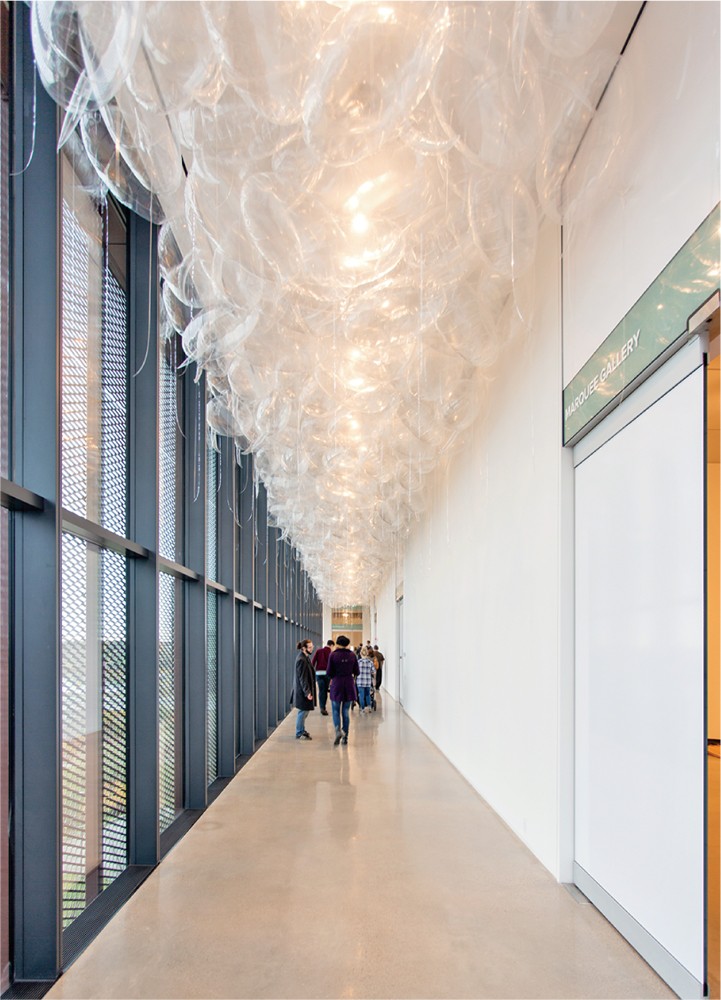Air and Running Water
In a book-form “conversation” between novelist Adam Thirwell and multimedia artist Philippe Parreno at the Serralves Museum of Contemporary Art in Porto in 2017, the novelist says to the artist, “I don’t want to talk about objects. I want to talk about spirits.” At the Remai Modern in Saskatoon, Canada’s newest museum (its grand opening was on October 21, 2017), it will be necessary to talk about both spirits and objects. The Remai will be helped with their object talk through the collection of 8,000 works inherited from its predecessor, the Mendel, which opened in 1964; it will be aided on the spirit side of its endeavour by the circumstances and history of the city where the new museum sits.

Remai Modern, Saskatoon, 2017. Photo: Adrien Williams.
Saskatoon is a city haunted by a richly layered and sometimes contentious history. Fred Mendel’s collection included fine examples of European and Canadian modernists, and in the five decades during which the gallery continued to collect, it also paid attention to the art being produced by the city’s artistic community. The inaugural exhibition at the Remai Modern indicates that Gregory Burke, the museum’s executive director and CEO, and Sandra Guimarães, Remai’s director of programs and chief curator, are aware of that legacy. The exhibition is called “Field Guide” and the name has deep resonances that take into account everything from Greenbergian formalism to Indigenous art making.
The formalism is addressed in works by Robert Christie, Eli Bornstein and William Perehudoff (the murals he designed for the reception room at Fred Mendel’s Intercontinental Packers have been carefully reinstalled in an upstairs gallery); the Indigenous presence is gathered together in an ambitious commissioned work by Duane Linklater and Tanya Lukin Linklater called Determined by the river, in which they have constructed a raft carrying 20 works by Indigenous artists drawn from the collection. The artists include, among many more, Bob Boyer, Daphne Odjig, Jessie Oonark, Robert Houle and Ruth Cuthand, as well as talismanic objects by Tanya herself.

Philippe Parreno, Speech Bubbles (Transparent), 2017, Mylar balloons, helium, 68 x 109 x 29 cm each. Courtesy of the artist and Esther Schipper, Berlin. Photo: Studio D.
“Field Guide” also contains a piece that makes a telling connection to the Linklater installation. The American artist Lawrence Weiner is represented by a signature text work from 2013 called MANY THINGS LEFT ON THE BANKS OF A RIVER INEVITABLY SWEPT INTO THE FLOW. Made in 2013, it reads like it was composed as a motto for the past and present conditions of the museum.
Additionally, there are works that respond to the history of Saskatoon itself, like Kara Uzelman’s installation dealing with the little-known history of LSD experiments in Saskatchewan and the invention of the word “psychedelic.” Uzelman’s work connects Regina and socialized medical care with Los Angeles and the psychedelic movement. It is that interaction between the local and the international that Guimarães sees as being essential to the museum’s mandate. She was inspired by the philosopher Éduoard Glissant and his idea of the museum as an inviting archipelago. “He was saying that you bring the local and the global together, touching each other and contaminating themselves without losing the essence of what they are. That’s how we’re thinking of the local and its encounter with the world.”

Eli Bornstein, maquette for Quadraplane Structurist Relief, No 15 II, 2016–2017, acrylic enamel on aluminum, 122 x 137 x 15.25 cm. Remai Modern Collection. Gift of the artist, 2017. Photo: Troy Mamer. All images courtesy Remai Modern.
Burke says the fundamental role a museum plays “is to ask questions.” He decided that the Remai would be a gallery of “modern art” because of the unique nature of the city and the province. “There are many reasons why I use the word ‘modern’: the whole history of Emma Lake, the support for modernism provided by Fred Mendel, the role that the progressive politics of Saskatchewan have played in a wider cultural context.” He realizes that the questions will not always be easy ones. The next major opening will be Jimmie Durham’s retrospective, “At the Centre of the World,” an exhibition and artist whose work raises important questions about who gets to call themselves Indigenous. “This debate is very interesting to me,” Burke says. “But I think that other questions are also important. Can an art museum play a role in fostering democracy at a point in time when democracy is fast disappearing? Can we form an agora here—a meeting place—where important issues of our day can be driven by the questions that artists are always asking?” One of the ways those questions and the artists and artworks that address them will be encouraged is through the unprecedented generosity of the woman after whom the museum is named. Through the Frank and Ellen Remai Foundation, Mrs Remai has gifted a total of $103 million, including an annual $1 million acquisition fund for each of the next 25 years.
In a poem written in 1962, two years before the Mendel opened to the public, Earle Birney suggested that in Canada, “it’s by our lack of ghosts we’re haunted.” He would be pleased to know that in Saskatoon there is some fortunate haunting going on. They can be seen in the airy spaces of the gallery designed by architect Bruce Kuwabara, although the spaces may be more eyrie than atmosphere. Birney opens his poem with the lines “Since we had always sky about, / When we had eagles they flew out.” In Saskatoon, in the upper reaches of the Remai Modern, there is plenty of flying and flowing going on. ❚

Walid Raad, Letters to the Reader, 2014, MDF wood, paint and wall text, 11 panels, 240 x 121.9 cm each. Courtesy of the artist and Paula Cooper Gallery, New York. © Walid Raad. Installation view, “Field Guide,” Remai Modern, Saskatoon, 2017. Photo: Stobbe Photography.

